

The Modern City: At 196,389 inhabitants, the Piraeus is actually the second largest city in Greece. But it sometimes seems more like a suburb of Athens (just take a look at the picture) than a city in its own right. Piraeus has been the port of Athens since classical times (see Pausanias 1.1.2 ) and has a few naturally protected harbors. It is really not a pleasant place (lots of traffic, pollution, etc.), but it can be tolerated on your way to the islands. I don't want to condemn the town, but I've seen warnings to nighttime visitors that they should confine their wanderings to the port while waiting on ships. It is still the most used port in the Mediterranean according to some guide books. All of the cruise ships that take you to the Cyclades and islands of the Saronic Gulf are here as are the boats to Crete and just about any other place you could want to go. I still wouldn't try to go from Piraeus to Brundisium (the closest port in Italy) as some people in my group this summer were considering. I would doubt that it is even possible. Be careful when you choose your ship. The ticket hawkers here are ruthless. The major ferries and departure points for the islands are listed at this link. Try it, since it's very useful to know from which dock you'll be leaving and you'll need to know ahead of time because some ships leave early in the morning and don't sail again till late. You'll also want to write down the telephone number 171. It can be reached 24 hrs, and it gives boat schedules and other transit information. Although you can also take a bus or a cab to Piraeus, the most convienent way to get there is the metro. You can hop on it at Omonia Square or just W of the Agora (among other stops).
The Ancient Port of Athens: The city has
some redeeming virtue to me though in its 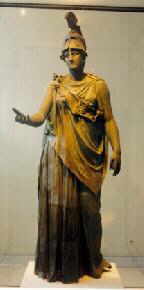 antiquities.
antiquities. 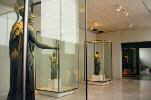 The Archaeological
Museum
(Charilaou Trikoupi 31; tel. 01 452 1598; Tue-Sun) here is not big,
but it has some of the best bronze statues that you will find anywhere, and
it is definitely worth your time. The statues were hidden during a raid
by Romans and were not recovered until the 1950's when they were found by
workmen digging a drain in the city. They are in great shape and the
head of Athena (pictured here) is on the 1000 drx. note (
photo
). There is a kouros of Apollo that is the earliest full-size bronze
statue to ever be discovered (520 B.C.). Downstairs, they also have
some notable relief sculptures found in the harbor earlier this century when
the government was digging around. Unfortunately there was surely
more sculpture and other items on the harbor floor before they sank tons
of tons of concrete for the modern port. All of which now will never
see the light of day. Some of the best pieces include a number of reliefs
produced by a single workshop that depict different scenes of the defeat
of the Amazons. The poses were taken directly from the shield of Athena
which stood beside her in the Parthenon. There are a number of fine
Roman busts, including heads of Claudius and Trajan. Another room on
the ground floor, not yet open during our visit, held a monumental tomb,
with some similarities to the Mausoleum at Halicarnassos, but obviously much
smaller. It has a pyramidal roof and statues of three men inside.
I wish I could remember where it was found and who it was depicting though.
The Archaeological
Museum
(Charilaou Trikoupi 31; tel. 01 452 1598; Tue-Sun) here is not big,
but it has some of the best bronze statues that you will find anywhere, and
it is definitely worth your time. The statues were hidden during a raid
by Romans and were not recovered until the 1950's when they were found by
workmen digging a drain in the city. They are in great shape and the
head of Athena (pictured here) is on the 1000 drx. note (
photo
). There is a kouros of Apollo that is the earliest full-size bronze
statue to ever be discovered (520 B.C.). Downstairs, they also have
some notable relief sculptures found in the harbor earlier this century when
the government was digging around. Unfortunately there was surely
more sculpture and other items on the harbor floor before they sank tons
of tons of concrete for the modern port. All of which now will never
see the light of day. Some of the best pieces include a number of reliefs
produced by a single workshop that depict different scenes of the defeat
of the Amazons. The poses were taken directly from the shield of Athena
which stood beside her in the Parthenon. There are a number of fine
Roman busts, including heads of Claudius and Trajan. Another room on
the ground floor, not yet open during our visit, held a monumental tomb,
with some similarities to the Mausoleum at Halicarnassos, but obviously much
smaller. It has a pyramidal roof and statues of three men inside.
I wish I could remember where it was found and who it was depicting though.
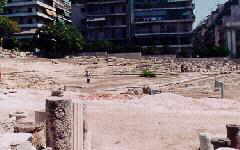 Right next door is the
Theater of Zea
, a 2nd century B.C. theater with a well preserved orchestra.
The Hellenistic theater is not very remarkable though. The cavea (seating
area) has 14 flights of steps and the orchestra is surrounded by a covered
channel (for drainage purposes). The site is currently being prepared
for more access to the public, but when I was there in the summer of 98, you
could only see it through the fences. An exit onto a platform or out
into the site will be made from inside the museum.
Right next door is the
Theater of Zea
, a 2nd century B.C. theater with a well preserved orchestra.
The Hellenistic theater is not very remarkable though. The cavea (seating
area) has 14 flights of steps and the orchestra is surrounded by a covered
channel (for drainage purposes). The site is currently being prepared
for more access to the public, but when I was there in the summer of 98, you
could only see it through the fences. An exit onto a platform or out
into the site will be made from inside the museum.
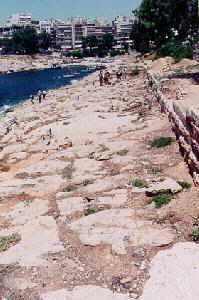 Today we can visit the archaeological museum or catch
our ferry to Crete, but in antiquity the Piraeus was known for a number of
different reasons. Before archaic times, the area was not very important
since swamps separated Athens from the town. The ships of Athens were
originally beached at Phaleron Bay, just to the east of Piraeus. But
that area didn't offer much natural protection and so one of the tyrants of
Athens, Hippias, began to fortify the hill known as Munychia at the end of
the 6C BC. When the Athenians began placing all their hopes on their
naval superiority, the Piraeus became more important. Still the famous
walls that surrounded the city and stretched all the way back to Athens were
only finished in 431, before the Peloponnesian War began. It was at
this time when the city plan was laid out, under Pericles, by Hippodamos,
on a grid pattern, a new development at the time. After Athens' defeat,
they were forced to tear the walls down. Sulla, the Roman dictator,
ravaged the city in 86 BC but as long as Athens had any importance, it was
able to function, and usually thrive, as the city's port. In recent
times, the population has risen almost exponentially, going from 4000 in 1840,
to 75,000 in 1907, and almost tripling that in the refugee settlement of
1922.
Today we can visit the archaeological museum or catch
our ferry to Crete, but in antiquity the Piraeus was known for a number of
different reasons. Before archaic times, the area was not very important
since swamps separated Athens from the town. The ships of Athens were
originally beached at Phaleron Bay, just to the east of Piraeus. But
that area didn't offer much natural protection and so one of the tyrants of
Athens, Hippias, began to fortify the hill known as Munychia at the end of
the 6C BC. When the Athenians began placing all their hopes on their
naval superiority, the Piraeus became more important. Still the famous
walls that surrounded the city and stretched all the way back to Athens were
only finished in 431, before the Peloponnesian War began. It was at
this time when the city plan was laid out, under Pericles, by Hippodamos,
on a grid pattern, a new development at the time. After Athens' defeat,
they were forced to tear the walls down. Sulla, the Roman dictator,
ravaged the city in 86 BC but as long as Athens had any importance, it was
able to function, and usually thrive, as the city's port. In recent
times, the population has risen almost exponentially, going from 4000 in 1840,
to 75,000 in 1907, and almost tripling that in the refugee settlement of
1922.
The walls of the Piraeus still attract attention today,
and they are hard to avoid if you drive by the sea's edge for even just a
few minutes. The walls were originally built by Themistocles in the
early 5C BC. The walls were rebuilt by Konon but probably not finished
until 364. These remnants are the ones most visible today. Towers
were constructed roughly every 50m. Along the S shore of the city, a walking
tour can take you past a number of these towers (and the Blue Guide gives
good details of what you would see along such a walk). A walk back to
the NE will carry you to the ancient harbor of Zea. This circular basin
was filled all around with 196 ship 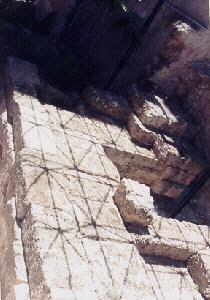 sheds that kept the Athenian triremes out of the water and offered places
to store their gear. Since so many large apartment buildings now run
almost to the water's edge, it is not easy for the average tourist to pinpoint
these unless with local help.
sheds that kept the Athenian triremes out of the water and offered places
to store their gear. Since so many large apartment buildings now run
almost to the water's edge, it is not easy for the average tourist to pinpoint
these unless with local help.
A particularly well known building, the Skenotheke (or Arsenal)
of Philon, is partially uncovered, and lies between two apartment buildings
just a block or two in, on the harbor's NE side. It was one of the most
admired buildings of the ancient world. Yes, you heard me correctly.
A storage shed for nautical equipment was compared by Pliny to the temple
of Artemis at Ephesos (Pliny NH 7.37.125). An inscription was
found, before the building was unearthed, that gave its exact dimensions and
even led the famous classicist William B. Dinsmoor to say "We knnow more about
its construction than if its actual remains, rather than the description had
been found." We know it is this building discovered in the Piraeus because
the dimensions match up perfectly. There is rarely a phylax there to
let you in, but along one side of the foundations a Plexiglas wall has been
installed to let you see them year-round (even though you are technically
in the foyer of an apartment building). [The skenotheke lies in between
the streets of Ypsilantou and Kontouriotou. The ancient building ran
all the way across Merarchias, and ended 2/3's of the way down the block towards
Bouboulinas. In between these four streets you should be able to find
the foundations. But be warned, they are not very exciting unless you
have read up a little on the subject and know why it was important.]
The harbor is bordered by a number of expensive shops
and restaurants and, possibly fulfilling the little harbor's expensive reputation,
the prominent yacht club crowns the high hill S of the basin at the same spot
where a classical Temple of Artemis once stood.
If you have no archaeological interests at all, you'll probably hurry through this town. It can be done that way after all, especially since the subway station terminates very close to the docks and you shouldn't have any problem getting to your boat. There is even a McDonalds right alongside the harbor ("Argh! I'll have the fish fillet extra value meal."). But if you have a little time on your hands, there are things to see in Piraeus, it just doesn't hurt to prepare.
Phaleron:
Historically important, if only briefly, today the area
(basically a part of Piraeus now) is home to the Stadium of Peace and Friendship,
a large indoor stadium. While I was in Athens this past summer of 98,
the city was hosting the World Championships of Basketball. And if you don't
think the Athenians were proud, you should check out the 100 drx. coins
that they minted commemorating the event! The metro that runs
from Athens to Piraeus stops right across the street from the stadium, giving
easy access to the large facility. It will be heavily used in the upcoming
Olympic Games. I had a great time (though Lithuania beat the U.S. that
day), and I saw teams from five different continents (Spain, U.S., Nigeria,
Argentina, Australia, S. Korea among others) play on one day in one building,
and all for 4000 drx. (about U.S.$15). While I was at the game I saw
Jerry West, John Wooden, and Quinn Buckner in the stands, along with Rudy
Tomjanovich, Dale Harris, and Lon Krueger (and even Sarunas Marcelionas for
Lithuania) coaching. 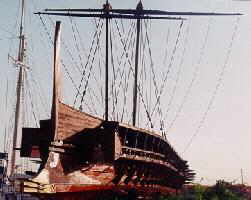 The only downside was that I was almost forcibly removed from the building
for putting my feet on the seat below me (I'm a pretty tall guy).
Another officer stopped the guy who just didn't seem to like me from kicking
me out. I'm pretty sure that there were just too many cops there with
too little to do that day.
The only downside was that I was almost forcibly removed from the building
for putting my feet on the seat below me (I'm a pretty tall guy).
Another officer stopped the guy who just didn't seem to like me from kicking
me out. I'm pretty sure that there were just too many cops there with
too little to do that day.
Also nearby, I'm not going to be much help with the directions
here, is the reconstructed trireme Olympias. Built in part by
Americans, British, and Greek classicists, architects, and engineers, all
using ancient sources and the 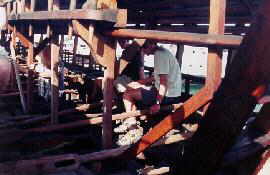 occasional traditional Greek methods, the ship is occasionally taken out
by the Greek Navy. When it was first built in the 1980's, it underwent
a number of test trials, but modern rowers were unable to duplicate the speeds
which classical triremes were supposed to have achieved. Today it is
a commissioned ship in the Greek Navy and it is usually kept high atop its
housing, on the water's edge. You can still drive right up to the
edge of it and see it from across the fence. I don't know for sure
though if the guards will let tourists walk up to it, though they were very
helpful with my group. The location is at a military port somewhere
along the Phaleron bay, but probably not too far from Piraeus. Sorry,
but I fell asleep on the bus ride that day.
occasional traditional Greek methods, the ship is occasionally taken out
by the Greek Navy. When it was first built in the 1980's, it underwent
a number of test trials, but modern rowers were unable to duplicate the speeds
which classical triremes were supposed to have achieved. Today it is
a commissioned ship in the Greek Navy and it is usually kept high atop its
housing, on the water's edge. You can still drive right up to the
edge of it and see it from across the fence. I don't know for sure
though if the guards will let tourists walk up to it, though they were very
helpful with my group. The location is at a military port somewhere
along the Phaleron bay, but probably not too far from Piraeus. Sorry,
but I fell asleep on the bus ride that day.
I would like to thank Andy Stewart and Julia Shear
for their explanations and tours of the Piraeus.
The Reconstructed Trireme Olympias:
Lots of bibliography coming soon...
contact me if you need it now.
Links: